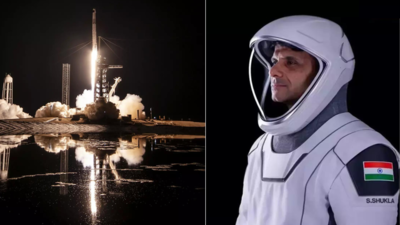The International Space Station (ISS) has welcomed its first Indian astronaut, Shubhanshu Shukla, amidst warm embraces and celebrations.

Shubhanshu Shukla's first video from space includes a greeting and the Indian flag.
The spacecraft, Grace, the fifth in the Dragon series, successfully docked with the ISS at 16.01 IST on Thursday, while passing over the North Atlantic Ocean.
Shukla is the second Indian to journey into space, following Rakesh Sharma’s historic flight in 1984. He is accompanied on the Axiom-4 mission by Slawosz Uznanski-Wisniewski, marking Poland’s return to space since 1978, and Tibor Kapu, the first Hungarian astronaut in 45 years. The crew launched from NASA's Kennedy Space Center on Wednesday.
India is making significant strides in space exploration, with several ambitious projects on the horizon:
Gaganyaan: India’s indigenous human spaceflight program, expected to launch by 2027. This mission aims to place India among the elite nations that have independently achieved manned space missions, including Russia, the United States, and China.
Shukla's Experiments: Shukla’s experiments on the Axiom-4 mission directly support the Gaganyaan program. His research focuses on the effects of microgravity on plant growth, muscle loss, mental health, and microbial behavior, crucial for long-term human spaceflight. He is also studying tardigrades to understand survival mechanisms in extreme conditions. These experiments aim to develop sustainable space food systems, ensure astronaut well-being, and strengthen life support strategies for future Indian space missions.
NISAR Satellite: NASA and ISRO are preparing to launch the $1.5 billion NISAR satellite in July from India’s Satish Dhawan Space Centre. This Earth-observing mission will utilize advanced radar to monitor surface changes, providing data on farming, climate, natural disasters, and more. Unlike most Earth-observing satellites limited by daylight and clear weather, NISAR offers 24/7, all-weather imaging. This will enable consistent monitoring of natural disasters, environmental shifts, and farming trends, making it a valuable tool for scientists, farmers, and disaster response teams globally.
Newer articles
 Indian Astronaut Joins ISS: Shukla's Mission Ushers in New Era for India's Space Program
Indian Astronaut Joins ISS: Shukla's Mission Ushers in New Era for India's Space Program
 Ashada Gupt Navratri 2025: Unveiling Dates, Sacred Rituals & Hidden Significance
Ashada Gupt Navratri 2025: Unveiling Dates, Sacred Rituals & Hidden Significance
 Rishabh Pant's Unconventional Batting Redefining Cricket, Says Greg Chappell
Rishabh Pant's Unconventional Batting Redefining Cricket, Says Greg Chappell
 Moto G54 Price Slashed in India: Check Out the New, Lower Cost
Moto G54 Price Slashed in India: Check Out the New, Lower Cost
 JPG to PDF: A Graphic Designer's Guide to File Conversion and Quality Preservation
JPG to PDF: A Graphic Designer's Guide to File Conversion and Quality Preservation
 'The Traitors' Star Apoorva Mukhija Accuses Sudhanshu Pandey of Misogyny and Verbal Abuse After On-Screen Drama
'The Traitors' Star Apoorva Mukhija Accuses Sudhanshu Pandey of Misogyny and Verbal Abuse After On-Screen Drama
 Van der Dussen to Captain South Africa in T20I Tri-Series Against New Zealand and Zimbabwe
Van der Dussen to Captain South Africa in T20I Tri-Series Against New Zealand and Zimbabwe
 20 Minutes to a Healthier Brain and Heart: Neurologist's Simple Strategies to Combat Cholesterol, Blood Pressure, and Dementia Risk
20 Minutes to a Healthier Brain and Heart: Neurologist's Simple Strategies to Combat Cholesterol, Blood Pressure, and Dementia Risk
 England's Audacious Batters Claim They Could Have Chased Down 450 in First Test Win Over India
England's Audacious Batters Claim They Could Have Chased Down 450 in First Test Win Over India
 Popular Finance YouTuber "financewithsharan" Hacked: Security Measures to Protect Your Account
Popular Finance YouTuber "financewithsharan" Hacked: Security Measures to Protect Your Account